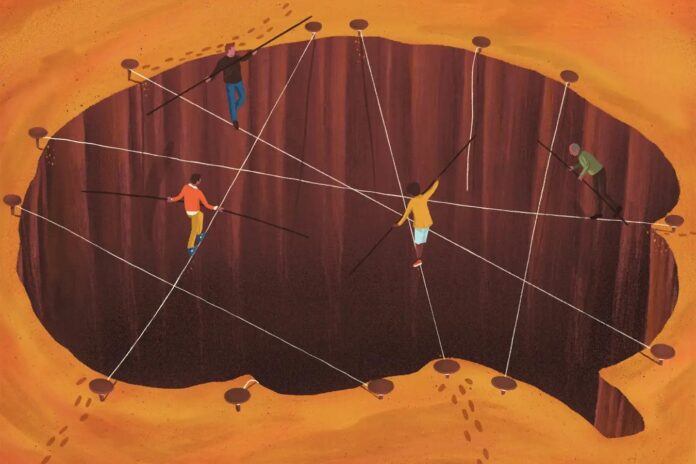Liberal democracy, with its promise of a future shaped by individual choice, presents a unique cognitive challenge. While economically, emotionally, and educationally impactful, a critical and often overlooked factor influencing our engagement with this system lies within the intricate workings of our brains. Research increasingly suggests that our inherent aversion to uncertainty, deeply rooted in our neurology, can make liberal democracy feel unsettling and leave us vulnerable to the allure of simplistic solutions offered by populist and authoritarian leaders.
The Brain’s Discomfort with Uncertainty
Human brains are wired to seek predictability. Throughout history, systems of governance have largely provided a degree of certainty about the future – a clear hierarchy, established traditions, or even a designated “fate.” Liberal democracy, however, inherently offers ambiguity. It throws open the future, presenting it as an open space subject to constant change based on our decisions, rather than a predetermined course. This shift, while politically empowering, can be neurologically jarring.
Research indicates that the discomfort of uncertainty can be more intense than even the prospect of negative experiences like receiving an electric shock. Historically, societies have developed mechanisms to mitigate this discomfort, ranging from insurance policies that protect against financial risk to weather forecasts that attempt to predict future conditions. These attempts to manage uncertainty reflect our brains’ inherent desire for a predictable environment.
Neurological Differences Between Liberal and Conservative Brains
The degree to which individuals tolerate uncertainty appears to be influenced by several factors, including cultural background, age, and gender. However, it also has a biological basis. Political neuroscience studies have revealed distinctions in brain structure between individuals who lean conservative and those who identify as liberal:
- Conservative Brains: These brains tend to favor security and demonstrate a reluctance toward open-ended solutions lacking clear conclusions. They often exhibit increased volume in the amygdala, the brain region responsible for threat detection and signaling. This heightened threat response contributes to discomfort when encountering novelty and unexpected events.
- Liberal Brains: Conversely, liberal brains tend to have a higher tolerance for ambiguity and conflict, often displaying greater grey matter volume in the anterior cingulate cortex, a brain area crucial for processing ambiguity.
The Rise of Populism and the Appeal of Illusions of Certainty
While liberal democracies can accommodate both neurological profiles under stable conditions, periods of heightened uncertainty – for example, related to environmental change, technological disruption, or shifting social norms – can push certain brains beyond their comfort zones. This neurological tension can lead individuals to seek solace in the promises of populist and authoritarian leaders. These figures often present simplistic solutions and promise to eliminate ambiguity by offering a “black-and-white” world view and a return to perceived “traditional” values.
This appeal isn’s always a matter of conscious choice. By rejecting new ideas – medicines, technologies – or foreigners, cultures, and religions, these leaders can create an illusion of certainty, effectively closing off the future and reducing anxiety, at the expense of progress and open-mindedness. This reduction of uncertainty is often more appealing to an anxious brain than the freedom inherent in a truly open society.
Educating the Electorate: Bridging the Neurological Divide
Importantly, this is not a situation where we are ‘stuck’ with inherently illiberal brains. Rather, liberal democracies must acknowledge and address the neurological challenges inherent in embracing liberal values.
This requires a more honest and nuanced approach to public discourse and education. Strategies should be developed to:
- Acknowledge the discomfort: Recognize that embracing liberalism may not come naturally to everyone, given their ingrained neurological tendencies.
- Highlight the benefits of cooperation: Communicate clearly how collaboration across diverse identity groups and interest groups can lead to positive outcomes.
- Frame challenges as solvable: Emphasize that major global challenges can only be overcome by understanding and mitigating our brains’ inherent vulnerabilities together.
By understanding the neurological roots of our attraction to certainty, liberal democracies can better equip their citizens to navigate an uncertain future and resist the temptation of simplistic solutions that ultimately undermine the values of freedom, progress, and open-mindedness.
Ultimately, acknowledging and addressing the neurological roots of our aversion to uncertainty is critical to preserving and strengthening liberal democratic societies. It’s about understanding how our brains are wired and adapting our strategies to overcome these vulnerabilities collectively.
Florence Gaub and Liya Yu, authors of The Future: A manual and Vulnerable Minds: The neuropolitics of divided societies, respectively, highlight the urgent need to incorporate insights from political neuroscience into our understanding of the challenges facing liberal democracies.
























